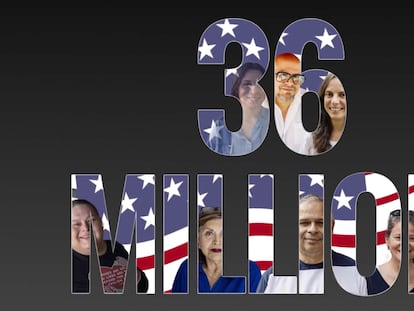‘Latino voters are more of a target for AI-generated fake news’
Juan Rosa, from the National Association of Latino Elected and Appointed Officials Educational Fund, warns of the risks that artificial intelligence will pose to the community in the November elections


Juan Rosa, 39, has a clear objective for the next five months: educate Latino voters about the risk posed by artificial intelligence (AI) in the face of the first U.S. presidential elections in the era of this technology. He will do so from his role as national director of civic engagement for the National Association of Latino Elected and Appointed Officials (NALEO) Educational Fund. It’s no easy task: 36 million Latinos will be able to vote on November 5, a record number. It is an electorate that has historically been the target of election disinformation campaigns and that now faces AI-generated fake news, which is easy to produce and spread, but difficult to distinguish, track, and combat.
Rosa is aware that the challenges posed by AI are even greater for Latinos because it is a community that “uses the internet for everything.” The vast majority get their information through social networks such as Facebook and communicate through encrypted messaging applications such as WhatsApp, where content moderation in Spanish is practically non-existent. To face this reality, the expert says that Latino voters need to develop “a healthy skepticism about the content” with which they interact and learn how to counteract the information they have received. To this end, NALEO launched a campaign called Defiende la Verdad (Defend the Truth) in 2022. This year, it has focused on the rise of AI in disinformation.
Question. Are Latinos especially vulnerable to misinformation?
Answer. I wouldn’t use the word vulnerable. I will say this: Latinos are well-positioned to be affected by fake information.
Q. Why?
A. Because a battery of studies have shown that the Latino community uses the internet for everything. For example, there’s a sizable portion of the community that relies on YouTube or Facebook for their news. And another big issue impacting Latinos in the United States is the use of encrypted technology for communication and networking. A lot of Latinos use WhatsApp or Telegram, which are encrypted tools that don’t allow for monitoring and removal of content. People share whatever they want, and it also allows for a lot of transnational sharing of information. So your tia [aunt] in the Dominican Republic or your tia in Colombia can send you information without vetting and without the capacity for it to be removed. So one of the things that makes Latinos especially well-positioned to the spread of misinformation is the fact that they’re so prevalent online.
Q. Is it easy to distinguish fake content from real content?
A. The Digital Democracy Institute of the Americas has done studies in which they actually show that Latinos actually understand when something is fake versus what is not. So the issue becomes: if Latinos are able to discern that something is false versus not, do they have the source to get the right information?
Q. In other words, it is not that the Latino community is naive, but that they’re participating in the channels where misinformation lives.
A. Right, particularly these encrypted networks, which are especially dangerous because they don’t allow for the monitoring or flagging of content.
Q. Are Spanish-speaking Latinos more susceptible than English-speakers?
A. Yes! One of our campaign strategies for Defiende la Verdad is social media monitoring. We get together at least twice a month, we gather volunteers, and we go online to search for keywords. And we do that because there has been a well-documented gap in social media companies’ ability to monitor for and remove content that is in languages other than English, including Spanish. That is a reality.
Q. How can the U.S. media, specifically Spanish-speaking media, play a bigger role in combating this issue?
A. One thing that we know, based on our research in 2019-2020, is that for Spanish-dominant Latinos, Spanish-speaking media is a trusted source of information. So we know that there is a promise there, we can have Spanish-speaking media become well-equipped to counter misinformation.
Q. We are less than five months away from the first U.S. elections in the year of artificial intelligence. How will this technology affect Latino voters?
A. It’s hard to know, we can only speculate. For example, one of the things that makes us concerned are things like what happened during the New Hampshire primary, where there were robocalls, automated calls, made to voters with the voice of Joe Biden urging folks not to go vote. Latinos have had that before in our history. Not robocalls, but throughout history, Latino neighborhoods have been flyered up with posters saying the wrong election day. Or saying that immigration authorities will be at the ballot box. Those things have already happened to Latinos, but now we have a technology that makes it so easy to produce and share misinformation and at the same time it’s very hard to track.
Q. How can it be combated?
A. There has been state-level legislation, in Florida for example, that mandates that political content made with AI needs to have a watermark. We applaud those efforts, but we don’t know how Latinos will learn about that. Who will tell Latinos about that watermark? Like you said, this is the year of AI, but we see it more as a feature of elections going forward, and it’s just one more thing we’re going to have to work around. Previously, our work was focused on educating people on their options: vote early, vote by mail, vote in person the day of the election... Now, we’ll also need to educate them on the type of content they receive, whether it’s real or not. What is a watermark? How will it show up?
Q. What will these educational campaigns look like?
A. In the immediate future, it’s going to be about helping them develop a healthy skepticism about the content and pointing them to the right source of information. The science is going to continue to evolve, so what we can do is use the tools that we do have, which is community education and partnerships with media companies.
Q. Precisely, AI is a technology that is advancing constantly. What we see now will look very different in 2028, when the next election rolls around.
A. It’s not even about 2028. We’re thinking as early as 2025, when New York City will elect a new mayor. Hundreds of thousands of Latinos will vote in the city. And then there’s the midterm elections in 2026. So the runway is short for us to wrap our head around how to include education on provenance, teaching people how to discern if something is fake or not and showing them where they can go to get the correct information.
Q. Thinking of this year’s and future elections, we know the Latino vote will be decisive as the Latino community grows in the United States. Will that make them more of a target?
A. Of course. As a community becomes more decisive, they become more of a target for bad actors that want to either get that vote through nefarious ways, or suppress it. That ongoing growth of the Latino vote will come with risks, such as people attempting to dissuade them from voting or confusing the community.
Sign up for our weekly newsletter to get more English-language news coverage from EL PAÍS USA Edition
Tu suscripción se está usando en otro dispositivo
¿Quieres añadir otro usuario a tu suscripción?
Si continúas leyendo en este dispositivo, no se podrá leer en el otro.
FlechaTu suscripción se está usando en otro dispositivo y solo puedes acceder a EL PAÍS desde un dispositivo a la vez.
Si quieres compartir tu cuenta, cambia tu suscripción a la modalidad Premium, así podrás añadir otro usuario. Cada uno accederá con su propia cuenta de email, lo que os permitirá personalizar vuestra experiencia en EL PAÍS.
¿Tienes una suscripción de empresa? Accede aquí para contratar más cuentas.
En el caso de no saber quién está usando tu cuenta, te recomendamos cambiar tu contraseña aquí.
Si decides continuar compartiendo tu cuenta, este mensaje se mostrará en tu dispositivo y en el de la otra persona que está usando tu cuenta de forma indefinida, afectando a tu experiencia de lectura. Puedes consultar aquí los términos y condiciones de la suscripción digital.
More information

Neither Trump nor Biden can win without Latinos: an X-Ray of 36 million voters
Archived In
Últimas noticias
Most viewed
- Sinaloa Cartel war is taking its toll on Los Chapitos
- Oona Chaplin: ‘I told James Cameron that I was living in a treehouse and starting a permaculture project with a friend’
- Reinhard Genzel, Nobel laureate in physics: ‘One-minute videos will never give you the truth’
- Why the price of coffee has skyrocketed: from Brazilian plantations to specialty coffee houses
- Silver prices are going crazy: This is what’s fueling the rally









































